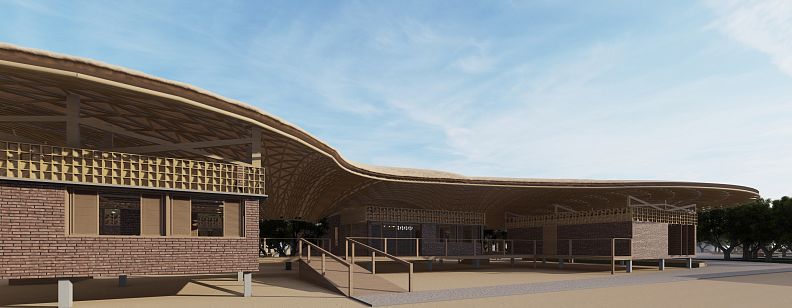Trou de Lumière

Project idea
The African continent faces severe consequences of the precariousness of resources and socioeconomic problems related to combating and treating the population in the face of epidemics and natural disasters. The city of Mbandaka, in the Democratic Republic of the Congo, the most biologically diverse country in Africa, exemplifies this scenario, where, in order to mitigate these issues, we propose to establish an Emergency Operations Center (EOC) to accommodate and treat the local population, as well as refugees coming from various locations in North Africa.
Based on the biomorphic form-generating process known as ‘caves and erosion’ (Agkathidis, 2017), alluding to the expression ‘opening of light” in the french dialect, the EOC is named T.R.L (Trou de Lumière), resulting from the idea of bringing natural light and ventilation into the building, similar to what an opening in a cave would do.
Project description
The program is fragmented into modulated components that would allow for access both from the neighboring Congo River and the adjacent Eala Avenue. Comprising of 435 m² total, it would include three main zones: (i) Medical - beds, sterile material center, ICU, laundry, operating rooms; blood bank, isolation and hemodialysis (243 m²); (ii) Administrative - reception; meeting room, toilets, screening (72 m²), and (iii) Service - bedrooms; locker rooms, storage, refectory, kitchen and pantry (120m2).
This strategy would also facilitate the construction in phases as needed, as well as, assure cross-ventilation and natural light throughout the complex during the whole year. Besides, morphologically it would establish a better relationship with the smaller scale, fragmented building masses in the surroundings.
Technical information
The design is based on creating inviting spaces that could bring an air of lightness to the site. To achieve this, we combined curvilinear shapes extracted from the outlines of the Congo River with cubic volumes in the neighboring areas.
Overall the proposal privileged earthy textures and tones typical in Mbandaka. For the landscaping we employed mostly natural pebble stone and green areas with native vegetation, as well as, reflective pools filled with reused and filtered water from the Congo River, featuring also playground areas with lightweight bamboo pavilions with synthetic reed ties for easy construction and maintenance.
To increase sustainability and reduce costs, we relied on local construction materials, such as: artisanal solid red brick for walls; caissadra wood for exterior decks and interior flooring; ceramic flooring for medical areas; for façades, sliding and pivoting wood shutters, and perforated wood elements were used; the main roof structure consisted of bamboo trusses with synthetic reed ties; and the main roof finish was comprised of stray over an impermeable plastic mat.










